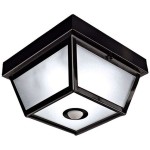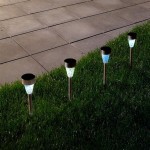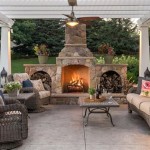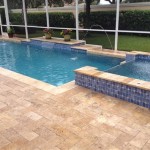Outdoor House Lights With Motion Sensor: Enhancing Security and Convenience
Outdoor house lights with motion sensors have become increasingly popular for residential and commercial properties. These lights offer a multifaceted approach to enhancing security, improving convenience, and contributing to energy savings. By automatically illuminating when movement is detected, they deter potential intruders, provide safe passage in dark areas, and reduce unnecessary energy consumption.
The underlying principle of a motion sensor light is relatively simple: it combines a light fixture with a motion-detecting sensor. The sensor is designed to detect movement within a specified range. When motion is identified, the sensor triggers the light to turn on. After a pre-determined period of inactivity, the light automatically switches off. This functionality differentiates them from standard outdoor lights that remain on continuously or require manual operation.
The increasing demand for these lights stems from their diverse applications and the benefits they provide to homeowners, businesses, and communities. This article will explore the components of motion sensor lights, their operational mechanisms, the advantages they offer, installation considerations, and the factors to consider when selecting the appropriate motion sensor light for a specific application.
Understanding the Components and Functionality
A motion sensor light system comprises several key components that work in conjunction to achieve its intended function. These include the light fixture itself, the motion sensor, and the control circuitry that governs the operation of the system.
The light fixture can incorporate various types of lighting technologies, including incandescent, halogen, LED, and CFL (compact fluorescent lamp). LED lights are increasingly favored due to their energy efficiency, extended lifespan, and improved light quality. LED fixtures also offer instant-on capabilities, which is a significant advantage for motion-activated security lighting.
The motion sensor is the core component responsible for detecting movement. Different types of motion sensor technologies are employed, including passive infrared (PIR), microwave, and dual-technology sensors. PIR sensors detect changes in infrared radiation (heat) emitted by moving objects. Microwave sensors, on the other hand, emit microwave signals and detect changes in the reflected signals caused by movement. Dual-technology sensors combine PIR and microwave technologies to reduce false alarms by requiring both technologies to trigger simultaneously.
The control circuitry manages the operation of the light based on the input from the motion sensor. It typically includes adjustable settings for sensitivity, duration, and range. Sensitivity controls the level of movement required to trigger the light. Duration determines how long the light remains on after motion is detected. Range defines the area within which the sensor can detect movement. These adjustments allow users to customize the performance of the light to suit their specific needs and environment.
The operational mechanism begins with the motion sensor constantly monitoring its surroundings for movement. When movement is detected within the sensor's range and exceeds the set sensitivity threshold, a signal is sent to the control circuitry. The circuitry then activates the light fixture, illuminating the area. A timer within the circuitry keeps the light on for the pre-set duration. If no further motion is detected during this period, the timer expires, and the circuitry switches off the light. If motion is detected again before the timer expires, the timer is reset, and the light remains on.
Sophisticated motion sensor lights may incorporate additional features, such as photocells that prevent the light from activating during daylight hours, and manual override switches that allow the light to be turned on continuously if needed. Some models also offer integration with smart home systems, enabling remote control and monitoring through smartphone apps or voice assistants.
The Advantages of Using Outdoor Motion Sensor Lights
The benefits of installing outdoor house lights with motion sensors are numerous, impacting security, safety, convenience, and energy consumption.
Enhanced Security: Perhaps the most significant advantage is the enhanced security they provide. The sudden illumination of a dark area can deter potential intruders and alert occupants to suspicious activity. Motion-activated lights can effectively discourage burglars and vandals, making a property a less appealing target. The element of surprise created by the sudden light can startle intruders, giving homeowners valuable time to react and contact authorities. Moreover, the increased visibility provided by the lights makes it easier to identify individuals and vehicles in the vicinity of the property.
Improved Safety and Convenience: Motion sensor lights significantly improve safety and convenience, particularly in dark or poorly lit areas. They provide illumination for walkways, driveways, and entryways, reducing the risk of slips, trips, and falls. This is particularly beneficial for elderly individuals or those with mobility limitations. Carrying groceries, unlocking doors, or navigating unfamiliar pathways becomes safer and easier with the automatic illumination provided by these lights. Furthermore, they eliminate the need to fumble for light switches in the dark, adding an element of convenience to everyday tasks.
Energy Savings: Compared to traditional lights that remain on continuously, motion sensor lights can significantly reduce energy consumption. They only activate when needed, minimizing the amount of time they are illuminated. This leads to lower electricity bills and a reduced carbon footprint. The energy savings are particularly noticeable when using LED fixtures, which are inherently more energy-efficient than other lighting technologies. The combination of motion-activated control and energy-efficient lighting makes motion sensor lights an environmentally responsible choice.
Reduced Light Pollution: By only illuminating when necessary, motion sensor lights help reduce light pollution, which is the excessive or misdirected artificial light that can disrupt natural ecosystems and obscure the night sky. Minimizing unnecessary light reduces the impact on nocturnal wildlife and allows for better visibility of stars and other celestial objects. This contributes to a more sustainable and environmentally friendly lighting solution.
Installation Considerations and Best Practices
Proper installation is crucial for ensuring the optimal performance and longevity of outdoor motion sensor lights. Several factors should be considered during the installation process.
Location Selection: The placement of the motion sensor light is critical for maximizing its effectiveness. The sensor should be positioned to cover the areas where motion detection is desired, such as entryways, driveways, and walkways. Avoid placing the sensor in locations where it could be triggered by moving trees, bushes, or passing traffic, as this can lead to false alarms. Consider the sensor's field of view and range when selecting the installation location. The height and angle of the sensor can also affect its performance. Generally, a higher mounting height provides a wider field of view, but it may also reduce the sensor's sensitivity to ground-level movement.
Wiring and Electrical Connections: Ensure that the electrical wiring complies with local building codes and regulations. If you are not comfortable working with electrical wiring, it is best to hire a qualified electrician to perform the installation. Before starting any electrical work, always turn off the power at the circuit breaker. Use appropriate wiring connectors and ensure that all connections are secure and properly insulated. Protect the wiring from moisture and environmental elements by using weatherproof junction boxes and sealant.
Adjusting the Settings: After installation, adjust the sensitivity, duration, and range settings to suit your specific needs and environment. Start with the lowest sensitivity setting and gradually increase it until the sensor reliably detects desired movement without triggering false alarms. The duration setting determines how long the light remains on after motion is detected. A shorter duration is generally sufficient for walkways and driveways, while a longer duration may be appropriate for larger areas. The range setting controls the distance at which the sensor can detect movement. Adjust this setting to cover the desired area without extending beyond your property boundaries.
Maintenance: Regular maintenance is necessary to keep your motion sensor lights functioning properly. Periodically clean the sensor lens with a soft, damp cloth to remove any dirt or debris that may be obstructing its view. Check the wiring connections to ensure they remain secure and corrosion-free. Replace light bulbs or LEDs when they burn out. Inspect the fixture and sensor housing for any signs of damage and repair or replace them as needed.
Troubleshooting: If your motion sensor light is not working correctly, there are several troubleshooting steps you can take. First, check the power supply to ensure that the circuit breaker is not tripped and that the wiring connections are secure. Next, check the sensor settings to ensure that the sensitivity and range are properly adjusted. If the light is still not working, try replacing the light bulb or LED. If none of these steps resolve the issue, consult the manufacturer's instructions or contact a qualified electrician.
Selecting the Right Motion Sensor Light: When selecting a motion sensor light, consider the following factors:
Light Output: The amount of light output required depends on the size of the area to be illuminated. For smaller areas, such as entryways, a lower light output may be sufficient. For larger areas, such as driveways or yards, a higher light output will be necessary. Consider the lumen rating of the light, which is a measure of the total amount of visible light emitted by the source. LED lights are typically more efficient than other types of lights, producing more lumens per watt of energy consumed.
Sensor Range and Sensitivity: Choose a sensor with a range and sensitivity that is appropriate for your needs. A longer range may be desirable for larger properties, while a shorter range may be sufficient for smaller properties. Adjustable sensitivity settings allow you to customize the sensor's response to different types of movement. Consider whether you need a sensor that can detect small animals or only larger objects.
Durability and Weather Resistance: Outdoor lights are exposed to the elements, so it is important to choose a fixture that is durable and weather-resistant. Look for fixtures that are made from corrosion-resistant materials, such as aluminum or stainless steel. Ensure that the fixture is rated for outdoor use and that it is sealed to prevent water from entering. Consider the climate in your area and choose a fixture that can withstand extreme temperatures, rain, snow, and wind.
Aesthetics: While functionality is important, you should also choose a motion sensor light that complements the style of your home. There are many different styles of motion sensor lights available, from traditional to modern. Choose a fixture that matches your home's architecture and landscaping. Consider the finish of the fixture and the type of lens used. A well-designed motion sensor light can enhance the curb appeal of your home while providing security and convenience.

Lnc Modern Black Motion Sensing Outdoor Sconce With Seeded Glass Shade Farmhouse 1 Light Front Door Wall Lantern 2 Pack Ev26jrhd1745dg8 The Home

Dusk To Dawn Motion Sensor Outdoor Porch Lights With Gfci Outlet Waterproof Light Fixture Anti Rust Exterior Wall Mount 3 Modes For House Garage Bulb Not Included Walmart Com

Uolfin Modern Black Drum Outdoor Wall Light Tora 1 Motion Sensor Lantern Sconce With Clear Glass Shade 2 Pack 628l8jyjmyb746d The Home

Outdoor Porch Light With Gfci Outlet For House Dusk To Dawn Motion Sensor Fixture Exterior Work Security Camera Waterproof Anti Rust Wall Lantern Balcony Garage Bulb Not Include Walmart Com

Lutec 1 Light Black Motion Sensing Outdoor Wall Lantern Sconce 5204101012 The Home

John Timberland Moray Bay Mission Outdoor Wall Light Fixture Black Motion Sensor Dusk To Dawn 11 1 2 Seedy Glass For Post Exterior Barn Deck House

Motion Sensor Outdoor Lights 3 Lighting Modes Led Integrated Porch 1200 Lumen Dusk To Dawn Outside Wall Light With Seeded Glass 13w Modern Exterior Fixture 3000k Sconce For House

Varennes Fixed Matt Black Pir Motion Sensor Outdoor Lantern Wall Light 60w Diy At B Q

Up And Down Pir Motion Sensor Wall Light For Outdoor Use

Boeka Arcturus 13 In Black Motion Sensor Dark Sky Integrated Outdoor Wall Light At Lowes Com








